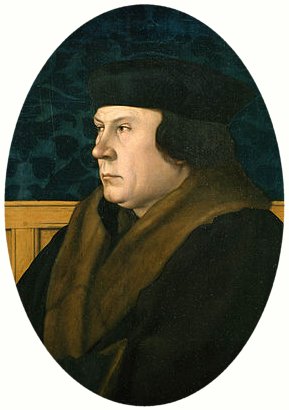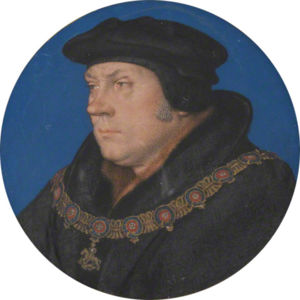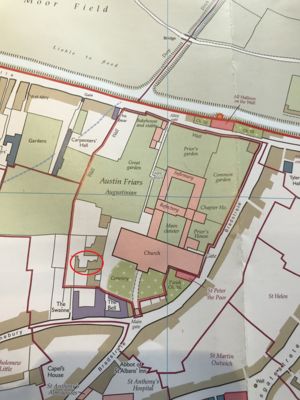| Thomas Cromwell KG PC is managed by the England Project. Join: England Project Discuss: england |
Contents |
Biography
Thomas Cromwell was born about 1484-5[1] in Putney, Surrey. While Putney today is a suburb of London, in the fifteenth century it was a small village six miles upstream from the king's palace at Whitehall and the archbishop's palace at Lambeth. He was the son of Walter Cromwell, a blacksmith, fuller and brewer in the village who held a number of copyholds from the Manor of Wimbledon, whose lord was the archbishop.
The manorial rolls for Wimbledon, which are full of mentions of Thomas' father have not one mention of him. As a child this would not be surprising but there are none after he came of age either. He gave a number of accounts to contemporaries as to what he did between 1502 and 1512 and as he was a man of incredible importance for ten years, several ambassadors described his background.
He fell out with his violent father and headed to the continent. Here he signed up as a mercenary and was part of the French army that was routed at the Battle of Garigliano[2]. He ended up in Florence and was taken in by the Frescobaldi family, becoming one of their agents in the Low Countries. By 1512 he was trading cloth in his own right[2].
In 1512 he was recorded as being in both the Netherlands (Middelburg) and in England and was working as both a merchant and a solicitor. In June 1514 Thomas was in Rome[3] acting as an agent for the Archbishop of York, handling ecclesiastical matters.
In those years he married Elizabeth Wykes the widow of Thomas Williams, a Yeoman of the Guard, and the daughter of a Putney shearman, Henry Wykes, who had served as a Gentleman Usher to King Henry VII. They went on to have three children together: Gregory, Anne and Grace, all before 1520.
In 1517-18 Thomas was back in Rome seeking to secure indulgences for the guild of Our Lady in Boston[3], a task he accomplished most efficiently. This work brought him to the attention of Cardinal Wolsey, Archbishop of York and King Henry VIII's Lord Chancellor who as Papal Legate was working on the Treaty of London. By 1519, Cromwell was performing work for the cardinal and over the next ten years rose steadily to become his right hand. Interestingly, at one point Wolsey tasked him with the dissolution of a number of priories to raise the funds to build Cardinal College.
He was still working as a merchant as well as a lawyer and in 1523 became an MP for one session of Parliament, an experience he found futile[4]. In 1524 he was elected a member of Gray's Inn[5]. By the mid-1520s a combination of his marriage, his cloth trading and his legal work meant he was exceptionally wealthy[3]. Unlike his contemporaries he made no attempt to spend this wealth building a great house. Instead he rented a house within the grounds of the Augustinian Friary of Austin Friars[6].

|
| Location of Cromwell's house in 1525 (red oval). |
1529 was Thomas' annus horribilis. An epidemic of sweating sickness swept through London. Thomas wrote his will leaving careful instructions as to how his fortune was to be divided[2]. He survived but his wife, Elizabeth, and both his daughters died within days of each other; he never remarried[2]. At the same time Cardinal Wolsey lost power over his failure to secure Henry a divorce, imperiling Cromwell as well[4].
And yet, within a month of Wolsey's fall, Cromwell had become an Member of Parliament again. The month after that Henry appointed him to the Privy Council[4]. He was clearly a man with a plan. His scheme was that Parliament would give Henry his divorce.
Following the fall of Wolsey, Sir Thomas More had become Chancellor. King Henry's court divided into two shifting factions, Radicals and Conservatives. This fracture would last for thirty years. The conservative group was led by More, Stephen Gardiner, the Bishop of Winchester and the Howard Family. The radical group by Cromwell, Archbishop Cranmer and the Seymour Family.
By May of 1532, Cromwell had driven More to resign and by May of 1533, Henry and Anne Boleyn were married and the union blessed by Cranmer[4]. In April 1534, Henry confirmed Thomas as his principal secretary and chief minister, a position which he had held for some time in all but name.
By 1535, Cromwell had established Henry as head of the church in England and completed the separation from Rome[4]. Cromwell, now appointed Vicegerent and Vicar-General, began to dissolve the monastic houses releasing vast amounts of land and wealth into the court and the English economy. Anne Boleyn took a position against this and it was fatal. The King despised women involved in the politics of the realm; this, her failure to produce a male heir and the King's growing infatuation with Jane Seymour meant her downfall. Cromwell, with typical efficiency, arranged for her arraignment, trial and execution[4].
From 1532 Cromwell had been acquiring land around Austin Friars including the Swanne Inn and the field just west of the Friary wall. He spent £550 on doing this, a simply enormous sum[6]. With the dissolution of the religious establishment he acquired all the non-religious buildings north and south of his original house. He set about building a mansion befitting the King's chief minister. He spent over £1000 from 1535 to 1539 creating a suitable house[6]. It had an imposing frontage on the street with three oriel windows above a large gateway and was set around three courtyards together with large gardens[6].

|
| Cromwell's new house at Austin Friars (3 marks the street frontage and entrance gate) |
In 1536, with the King's marriage to Jane Seymour, Cromwell's power reached its zenith. He was created Baron Cromwell of Okeham in the County of Rutland [7]. His son, Gregory, married one of the Seymours, Elizabeth.
Jane's death the following year caused Thomas problems. He was told to arrange another marriage for the King. The resulting betrothal to Anne of Cleves was a disaster. They met on New Year's Day, 1540 and the King was not taken with her ("I like her not!"). While the marriage took place it was not consummated.
Cromwell was made Earl of Essex in April[4] and yet his hold on power was failing. Gardiner and the Howards used Catherine Howard to entice Henry. In June, Thomas was arrested at a Council meeting, condemned to death without trial and beheaded on Tower Hill on 28 July 1540, the day of the King's marriage to Catherine. His head was placed on a spike on London Bridge.
Within a few months Henry was openly lamenting that under pretext of some slight offences which he had committed, they had brought several accusations against him, on the strength of which he had put to death the most faithful servant he ever had[8].
Offices held by Thomas Cromwell
- Commissioner for the Subsidy, London 1524, Kent 1534, for printing of the Bible 1539, for sale of crown lands 1539, 1540
- Councillor, Member of the King's Council by January 1531
- Master of King's Jewel House jointly with Sir John Williams 14 April 1532, c. 1533–1540
- Clerk of the Hanaper 16 July 1532, jointly with Ralph Sadler Apr. 1535–1540
- Chancellor of the Exchequer 12 April 1533–1540
- Recorder, Bristol 1533–1540
- Steward, Westminster Abbey 12 September 1533, jointly with Robert Wroth 14 February 1534 – May 1535
- Lordships of Edmonton and Sayesbery, Middlesex May 1535, of Havering-atte-Bower, Essex December *1537 manor of Writtle, Essex June 1536, Honour of Rayleigh, Essex September 1539
- Surveyor of the King's Woods, jointly with Sir William Paulet by 1533
- Principal Secretary c. April 1534 – April 1540
- Master of the Rolls 8 October 1534–10 July 1536
- Constable jointly with Richard Williams (alias Cromwell) of Hertford Castle, Hertfordshire 1534–1540, *Berkeley Castle, Gloucestershire 1535–d., sole, Leeds Castle, Kent 4 January 1539–1540
- Visitor-General of the Monasteries 21 January 1535
- Steward, Duchy of Lancaster, Essex, Hertfordshire and Middlesex 12 May 1535–1540
- Steward of Savoy Manor May 1535–1540
- Chancellor, High Steward and Visitor, Cambridge University 1535–1540
- Commissioner for the Peace, Bristol, Kent, Middlesex, Surrey 1535–1540, Essex 1536–1540, Derbyshire, *Westmorland 1537–1540, all counties 1538–1540
- Prebendary of Salisbury, May 1536–1540
- Receiver of Petitions in the Lords, Parliament of 1536
- Trier, Parliament of 1539
- Lord Privy Seal, 2 July 1536–1540
- Vicar-General and Vicegerent of the King in spirituals, 18 July 1536
- Dean of Wells, 1537–1540
- Warden and Chief Justice in Eyre, North of Trent, 30 December 1537–1540
- Governor of the Isle of Wight, 2 November 1538–1540
- Great Chamberlain, 17 April 1540
- Earl of Essex, 18 April 1540
Research Notes
Thomas Cromwell is also alleged to have had an illegitimate daughter, Jane. Jane married William Hough, of Leighton in Wirral, Cheshire, sometime about 1550.
Sources
- ↑ The New England historical and genealogical register; by Waters, Henry F. (Henry Fitz-Gilbert); Publication date Jan 1897; Vol 51; p. 211 https://archive.org/stream/newenglandhistor51wate#page/210/mode/2up
- ↑ 2.0 2.1 2.2 2.3 Life and letters of Thomas Cromwell by Merriman, Roger Bigelow; Publication date: 1902; page 2 https://archive.org/stream/thomascromwell00merruoft#page/2/mode/2up
- ↑ 3.0 3.1 3.2 Thomas Cromwell’s life before Henry VIII; Dr Catherine Fletcher; 2015 https://www.historyextra.com/period/medieval/thomas-cromwells-life-before-henry-viii/
- ↑ 4.0 4.1 4.2 4.3 4.4 4.5 4.6 Leithead, Howard (January 2008) . "Cromwell, Thomas, Earl of Essex (b. in or before 1485, d. 1540)". Oxford Dictionary of National Biography (online ed.). Oxford University Press.
- ↑ Foster, Joseph. The Register of Admissions to Gray's Inn, 1521-1889 (The Hansard Publishing Union, Ltd., London, 1889) Page 31: "1524. folio 298. Thomas Cromwell (Earl of Essex)."
- ↑ 6.0 6.1 6.2 6.3 Holder, Nick (2017). The Friaries of Medieval London: From Foundation to Dissolution. Woodbridge: Boydell. pp. 119–41. ISBN 9781783272242.
- ↑ Letters and Papers, Foreign and Domestic, Henry VIII, 11, 202(3) and 202(14). https://www.british-history.ac.uk/letters-papers-hen8/vol11/pp73-89
- ↑ Letters and Papers, Foreign and Domestic, Henry VIII, 16, 590 https://www.british-history.ac.uk/letters-papers-hen8/vol16/pp282-289
See Also:
- "Venice: July 1540," in Calendar of State Papers Relating To English Affairs in the Archives of Venice, Volume 5, 1534-1554, ed. Rawdon Brown (London: Her Majesty's Stationery Office, 1873), 84-87. British History Online, accessed December 26, 2021, http://www.british-history.ac.uk/cal-state-papers/venice/vol5/pp84-87.
- "Venice: August 1540," in Calendar of State Papers Relating To English Affairs in the Archives of Venice, Volume 5, 1534-1554, ed. Rawdon Brown (London: Her Majesty's Stationery Office, 1873), 87. British History Online, accessed December 26, 2021, http://www.british-history.ac.uk/cal-state-papers/venice/vol5/p87.
- Wikipedia contributors, "Thomas Cromwell," Wikipedia, The Free Encyclopedia, https://en.wikipedia.org/w/index.php?title=Thomas_Cromwell&oldid=927256892 (accessed December 5, 2019).
- Noble, Mark. Memoirs of the Protectoral-House of Cromwell, 3rd edition (London, 1787) Vol. 1, Page 14
- Borman, Tracy. Thomas Cromwell : The Untold Story of Henry VIII’s Most Faithful Servant. London: Hodder & Stoughton, 2014.
- MacCulloch, Diarmaid. Thomas Cromwell: A Life. Penguin UK, 2018. Google Books preview
- Silva, Alvaro. “Thomas Cromwell: The Rise and Fall of Henry VIII’s Most Notorious Minister.” Moreana; Angers 47, no. 179/180 (June 2010): 249–52. Proquest (subscription required)
No known carriers of Thomas's DNA have taken a DNA test. Have you taken a test? If so, login to add it. If not, see our friends at Ancestry DNA.
Featured Eurovision connections: Thomas is 33 degrees from Agnetha Fältskog, 21 degrees from Anni-Frid Synni Reuß, 27 degrees from Corry Brokken, 22 degrees from Céline Dion, 22 degrees from Françoise Dorin, 22 degrees from France Gall, 22 degrees from Lulu Kennedy-Cairns, 28 degrees from Lill-Babs Svensson, 20 degrees from Olivia Newton-John, 31 degrees from Henriette Nanette Paërl, 30 degrees from Annie Schmidt and 18 degrees from Moira Kennedy on our single family tree. Login to see how you relate to 33 million family members.
C > Cromwell > Thomas Cromwell KG PC
Categories: Knights Companion of the Garter, Henry VIII creation | Masters of the Rolls | Masters of the Jewel Office | Chancellors of the Exchequer | Barons in the Peerage of England | Lord Keeper of the Privy Seal | Earls of Essex | England Managed Profiles, Pre-1500 | People Executed by the Tudors | Featured Connections Archive 2022





https://www.youtube.com/watch?v=M6K2DsvVTjA
We are featuring this profile in the Connection Finder this week. Between now and Wednesday is a good time to take a look at the sources and biography to see if there are updates and improvements that need made, especially those that will bring it up to WikiTree Style Guide standards. We know it's short notice, so don't fret too much. Just do what you can.
Thanks!
Abby
In England the Middle Ages are often said to end with the Battle of Bosworth in 1485. In reality they end with Cromwell's separation of the English church and his destruction of the religious houses. This liberated the immense stored wealth of the centuries since the conquest into the English economy. It directly led to the establishment of a Middle Class, the Elizabethan Golden Age and England taking its place as a world power.
Please change "becoming on" to "becoming one"
https://www.wikitree.com/wiki/Hough-2179
"Thomas Cromwell, 1st and last Earl of Essex." The Peerage.com (http://www.thepeerage.com/p13113.htm#i131126)
Many Thanks
"Danny Dyer." Who do you think you are? (Series 13, Episode 1). BBC One. 24 November 2016.
Actor Danny Dyer is a direct descendant of Thomas Cromwell.
Many thanks.